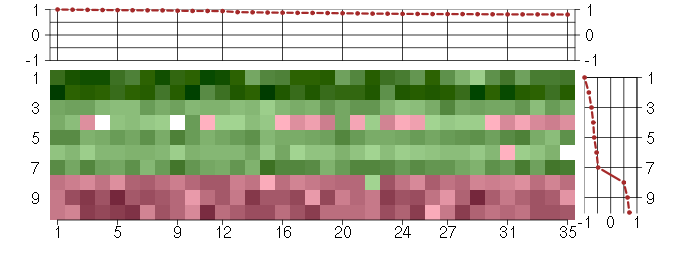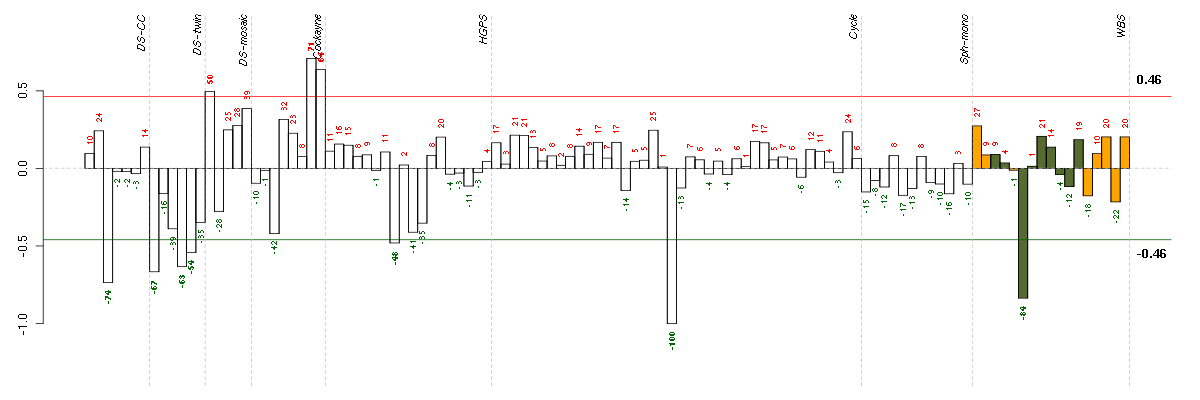



Under-expression is coded with green,
over-expression with red color.

biological_process
Any process specifically pertinent to the functioning of integrated living units: cells, tissues, organs, and organisms. A process is a collection of molecular events with a defined beginning and end.
cellular process
Any process that is carried out at the cellular level, but not necessarily restricted to a single cell. For example, cell communication occurs among more than one cell, but occurs at the cellular level.
cellular component organization
A process that is carried out at the cellular level which results in the formation, arrangement of constituent parts, or disassembly of a cellular component.
membrane organization
A process that is carried out at the cellular level which results in the formation, arrangement of constituent parts, or disassembly of a membrane. A membrane is a double layer of lipid molecules that encloses all cells, and, in eukaryotes, many organelles; may be a single or double lipid bilayer; also includes associated proteins.
all
This term is the most general term possible

plasma membrane
The membrane surrounding a cell that separates the cell from its external environment. It consists of a phospholipid bilayer and associated proteins.
membrane
Double layer of lipid molecules that encloses all cells, and, in eukaryotes, many organelles; may be a single or double lipid bilayer; also includes associated proteins.
integral to membrane
Penetrating at least one phospholipid bilayer of a membrane. May also refer to the state of being buried in the bilayer with no exposure outside the bilayer. When used to describe a protein, indicates that all or part of the peptide sequence is embedded in the membrane.
integral to plasma membrane
Penetrating at least one phospholipid bilayer of a plasma membrane. May also refer to the state of being buried in the bilayer with no exposure outside the bilayer.
cellular_component
The part of a cell or its extracellular environment in which a gene product is located. A gene product may be located in one or more parts of a cell and its location may be as specific as a particular macromolecular complex, that is, a stable, persistent association of macromolecules that function together.
cell
The basic structural and functional unit of all organisms. Includes the plasma membrane and any external encapsulating structures such as the cell wall and cell envelope.
oncostatin-M receptor complex
A heterodimeric receptor for the cytokine oncostatin-M (OSM). In humans the receptor complex is made up of the gene products gp130 and OSMR-beta.
intrinsic to membrane
Located in a membrane such that some covalently attached portion of the gene product, for example part of a peptide sequence or some other covalently attached moiety such as a GPI anchor, spans or is embedded in one or both leaflets of the membrane.
intrinsic to plasma membrane
Located in the plasma membrane such that some covalently attached portion of the gene product, for example part of a peptide sequence or some other covalently attached moiety such as a GPI anchor, spans or is embedded in one or both leaflets of the membrane.
macromolecular complex
A stable assembly of two or more macromolecules, i.e. proteins, nucleic acids, carbohydrates or lipids, in which the constituent parts function together.
protein complex
Any macromolecular complex composed of two or more polypeptide subunits, which may or may not be identical. Protein complexes may have other associated non-protein prosthetic groups, such as nucleotides, metal ions or carbohydrate groups.
receptor complex
Any protein complex that undergoes combination with a hormone, neurotransmitter, drug or intracellular messenger to initiate a change in cell function.
membrane part
Any constituent part of a membrane, a double layer of lipid molecules that encloses all cells, and, in eukaryotes, many organelles; may be a single or double lipid bilayer; also includes associated proteins.
plasma membrane part
Any constituent part of the plasma membrane, the membrane surrounding a cell that separates the cell from its external environment. It consists of a phospholipid bilayer and associated proteins.
cell part
Any constituent part of a cell, the basic structural and functional unit of all organisms.
all
This term is the most general term possible
cell part
Any constituent part of a cell, the basic structural and functional unit of all organisms.
membrane part
Any constituent part of a membrane, a double layer of lipid molecules that encloses all cells, and, in eukaryotes, many organelles; may be a single or double lipid bilayer; also includes associated proteins.
plasma membrane part
Any constituent part of the plasma membrane, the membrane surrounding a cell that separates the cell from its external environment. It consists of a phospholipid bilayer and associated proteins.
oncostatin-M receptor complex
A heterodimeric receptor for the cytokine oncostatin-M (OSM). In humans the receptor complex is made up of the gene products gp130 and OSMR-beta.
intrinsic to plasma membrane
Located in the plasma membrane such that some covalently attached portion of the gene product, for example part of a peptide sequence or some other covalently attached moiety such as a GPI anchor, spans or is embedded in one or both leaflets of the membrane.
integral to plasma membrane
Penetrating at least one phospholipid bilayer of a plasma membrane. May also refer to the state of being buried in the bilayer with no exposure outside the bilayer.
oncostatin-M receptor complex
A heterodimeric receptor for the cytokine oncostatin-M (OSM). In humans the receptor complex is made up of the gene products gp130 and OSMR-beta.

protein binding
Interacting selectively with any protein or protein complex (a complex of two or more proteins that may include other nonprotein molecules).
molecular_function
Elemental activities, such as catalysis or binding, describing the actions of a gene product at the molecular level. A given gene product may exhibit one or more molecular functions.
signal transducer activity
Mediates the transfer of a signal from the outside to the inside of a cell by means other than the introduction of the signal molecule itself into the cell.
receptor activity
Combining with an extracellular or intracellular messenger to initiate a change in cell activity.
transmembrane receptor activity
Combining with an extracellular or intracellular messenger to initiate a change in cell activity, and spanning to the membrane of either the cell or an organelle.
cytokine receptor activity
Combining with a cytokine to initiate a change in cell activity.
oncostatin-M receptor activity
Combining with oncostatin-M to initiate a change in cell activity.
binding
The selective, often stoichiometric, interaction of a molecule with one or more specific sites on another molecule.
cytokine binding
Interacting selectively with a cytokine, any of a group of proteins that function to control the survival, growth and differentiation of tissues and cells, and which have autocrine and paracrine activity.
molecular transducer activity
The molecular function that accepts an input of one form and creates an output of a different form.
all
This term is the most general term possible
cytokine receptor activity
Combining with a cytokine to initiate a change in cell activity.
ATP13A3ATPase type 13A3 (219558_at), score: 0.94 ATP6V1AATPase, H+ transporting, lysosomal 70kDa, V1 subunit A (201971_s_at), score: 0.83 CDV3CDV3 homolog (mouse) (213548_s_at), score: 1 COPAcoatomer protein complex, subunit alpha (214336_s_at), score: 0.98 CPDcarboxypeptidase D (201942_s_at), score: 0.97 CYP51A1cytochrome P450, family 51, subfamily A, polypeptide 1 (216607_s_at), score: 0.85 DAZAP2DAZ associated protein 2 (212595_s_at), score: 0.82 DDX3XDEAD (Asp-Glu-Ala-Asp) box polypeptide 3, X-linked (201211_s_at), score: 0.99 DHX9DEAH (Asp-Glu-Ala-His) box polypeptide 9 (212105_s_at), score: 0.97 FN1fibronectin 1 (214701_s_at), score: 0.84 GNA13guanine nucleotide binding protein (G protein), alpha 13 (206917_at), score: 0.84 GNSglucosamine (N-acetyl)-6-sulfatase (203676_at), score: 0.97 GTF2Igeneral transcription factor II, i (210892_s_at), score: 0.87 HSPA4heat shock 70kDa protein 4 (211016_x_at), score: 0.83 IL6STinterleukin 6 signal transducer (gp130, oncostatin M receptor) (204864_s_at), score: 0.94 LMAN1lectin, mannose-binding, 1 (203294_s_at), score: 0.9 MAP3K7IP2mitogen-activated protein kinase kinase kinase 7 interacting protein 2 (210284_s_at), score: 0.89 NOTCH2Notch homolog 2 (Drosophila) (210756_s_at), score: 0.82 OSMRoncostatin M receptor (205729_at), score: 0.82 PAFAH1B1platelet-activating factor acetylhydrolase, isoform Ib, alpha subunit 45kDa (211547_s_at), score: 0.81 PCDHGA11protocadherin gamma subfamily A, 11 (211876_x_at), score: 0.97 PCDHGA3protocadherin gamma subfamily A, 3 (216352_x_at), score: 0.86 PHTF2putative homeodomain transcription factor 2 (217097_s_at), score: 0.94 PICALMphosphatidylinositol binding clathrin assembly protein (215236_s_at), score: 0.82 RAB5ARAB5A, member RAS oncogene family (206113_s_at), score: 0.95 SCAMP1secretory carrier membrane protein 1 (206667_s_at), score: 0.88 SCARB2scavenger receptor class B, member 2 (201647_s_at), score: 0.87 SNAP23synaptosomal-associated protein, 23kDa (214544_s_at), score: 0.8 STIP1stress-induced-phosphoprotein 1 (212009_s_at), score: 0.81 TGFBR2transforming growth factor, beta receptor II (70/80kDa) (207334_s_at), score: 0.87 UBXN4UBX domain protein 4 (212008_at), score: 0.85 VAMP3vesicle-associated membrane protein 3 (cellubrevin) (201337_s_at), score: 0.81 WACWW domain containing adaptor with coiled-coil (219679_s_at), score: 0.99 ZFAND5zinc finger, AN1-type domain 5 (217741_s_at), score: 0.81 ZMYND11zinc finger, MYND domain containing 11 (202137_s_at), score: 0.81
| Id | sample | Experiment | ExpName | Array | Syndrome | Cell.line |
|---|---|---|---|---|---|---|
| E-TABM-263-raw-cel-1515486031.cel | 20 | 6 | Cycle | hgu133a2 | none | Cycle 1 |
| 5042_CNTL.CEL | 6 | 8 | WBS | hgu133plus2 | none | WBS 1 |
| ctrl c 08-03.CEL | 3 | 1 | DS-CC | hgu133a | none | DS-CC 3 |
| 1Twin.CEL | 1 | 2 | DS-twin | hgu133plus2 | Down | DS-twin 1 |
| 4Twin.CEL | 4 | 2 | DS-twin | hgu133plus2 | none | DS-twin 4 |
| 5CTwin.CEL | 5 | 2 | DS-twin | hgu133plus2 | Down | DS-twin 5 |
| E-GEOD-3860-raw-cel-1561690304.cel | 8 | 5 | HGPS | hgu133a | none | GMO8398C |
| 46A.CEL | 1 | 3 | DS-mosaic | hgu133plus2 | none | DS-mosaic 1 |
| E-GEOD-3407-raw-cel-1437949938.cel | 8 | 4 | Cockayne | hgu133a | none | CSB |
| E-GEOD-3407-raw-cel-1437949854.cel | 7 | 4 | Cockayne | hgu133a | CS | eGFP |
